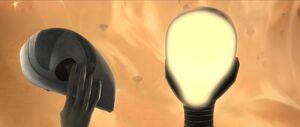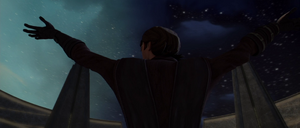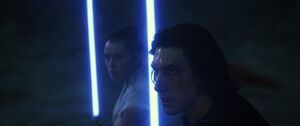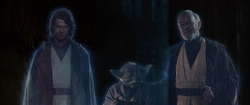| | |
- "How am I to know the good side from the bad?"
"You will know, when you are calm. At peace, passive." - ―Luke Skywalker and Yoda

Ancient symbol of the light side of the Force
The light side of the Force, also known as Ashla,[2] was one of two methods of using the Force. The light side was aligned with calmness, peace, and passiveness, and was used only for knowledge and defense.[1] The Jedi were notable practitioners of the light, being selfless servants of the will of the Force,[3] and their enemies, the Sith followed the dark side of the Force.[4]
Essence of the light side[]
Selflessness[]
- "You don't understand what you're asking me to do."
"Yes, I do; you can't save your master, and I can't save mine. I'm asking you to let go." - ―Ezra Bridger is guided by Ahsoka Tano to let go

The light side of the Force was selflessness; the Jedi's purpose was exemplified by their acts of altruism and letting go.
The light side of the Force was selflessness. Its Jedi practitioners lived in the present,[4] clearing their mind, letting go of their consciousness, and listening to the Force, acting on instinct.[6] The Jedi Order, which was devoted to the light side of the Force,[7] had the core principle of being the guardians of peace and justice,[8] which was exemplified by their altruism during the High Republic Era.[9] As decreed by the Jedi Code,[10] Jedi were committed to compassion—unconditional love for all living things.[4] Compassionate actions extended to dying, as a member of the Jedi Order believed in loss in the service of a greater good. Recognizing this gave one mastery in the Force, allowing a Jedi to repel spirit.[11] The anchorite sect, bound to the Order and aligned with the light side of the Force, believed that suffering was the basis of life; that one should not ask for a life of any merit, for self-sacrifice is reward enough.[12]
The Force did not belong to the Jedi or any other organization—some individuals who were not part of any religion also believed in selflessness. Such included the Spectres rebel cell, whose leader, Hera Syndulla, taught the young Ezra Bridger that when one finds people who need one's help, one helps them no matter what, and that if all one does is fight for their own life, then one's life is worth nothing.[13]
Balance of the Force[]
Description[]
- "We call upon the Three. Light. Dark. And Balance true. One is no greater than the others. Together, they unite, restore, center, and renew. We walk into the light, acknowledge the dark, and find balance within ourselves. The Force is strong."
- ―Incantation recited by Dooku, Lene Kostana, and Sifo-Dyas

Those who have wholly devoted themselves to the Force were able to retain their consciousness after death, achieving immortality by becoming one with the Cosmic Force.
Balance in the Force—harmony between all life—was achieved and maintained through understanding and accepting the dark side of the Force that exists within oneself, while serving the light side of the Force; practitioners of this method, namely Jedi, devoted themselves to the will of the Force,[3][1] acting in accordance to the symbiotic relationship between the Living Force and the Cosmic Force—the transformation of the energy of all life to the greater energy field that bound everything—by submitting to the Cosmic Force and what it communicated to them through the midi-chlorians.[15]
History[]
The Chosen One[]
- "A Chosen One shall come, born of no father, and through him will ultimate balance in the Force be restored."
- ―A Jedi prophecy

Anakin Skywalker was a Jedi Knight and the prophesied Chosen One destined to bring balance to the Force.
Prior to the fall of the Galactic Republic, there was an ancient prophecy that foretold of a being that would bring balance to the Force: the Chosen One.[4] The Jedi Order believed the Chosen One would destroy the Sith and bring balance to the Force.[17] Jedi Master Qui-Gon Jinn discovered a human boy on Tatooine with no father—Anakin Skywalker—and believed him to be possibly conceived by the midi-chlorians, as the prophecy foretold. Skywalker was trained as a Jedi by Jinn's Padawan, Obi-Wan Kenobi,[4] but he fell to the dark side of the Force in his inability to let go of his lover, Padmé Amidala, and in his self-hatred and lust for power, became apprenticed to the Dark Lord of the Sith Darth Sidious as Darth Vader.[17] However, years later,[18] the son of Anakin Skywalker and Padmé Amidala, the Jedi Knight Luke Skywalker, swayed Vader to sacrifice himself to destroy Darth Sidious.[19] With the Sith extinct, Anakin Skywalker thus fulfilled the prophecy of the Chosen One and brought balance to the Force.[20][21]
The dyad[]
- "My mother was the daughter of Vader. Your father was the son of the Emperor. What Palpatine doesn't know is we're a dyad in the Force, Rey. Two that are one."
- ―Kylo Ren, to Rey

Rey, the granddaughter of Darth Sidious, and Ben Solo, the grandson of Anakin Skywalker, formed a rare and powerful Force dyad.
After the Chosen One restored balance to the Force, Force-sensitives Ben Solo, the grandson of Anakin Skywalker, and Rey,[22] the secret granddaughter of Darth Sidious,[23] who trained as a Jedi under Luke Skywalker[22] and his sister, Leia Organa, came to the forefront of the war between the First Order and the Resistance. The two were eventually bonded by the Force into one entity before it; a unique dyadic Force-bond[24] that transcended physical and mental barriers between the individuals. Through their bond, Ben Solo and Rey were able to destroy the last Sith Lord, a revived Darth Sidious, and thus return balance to the Force as Anakin Skywalker had.[23]
Force powers[]
- "A Jedi uses the Force for knowledge and defense… never for attack."
- ―Yoda, to Luke Skywalker
The light side of the Force was primarily used for defensive abilities as opposed to aggressive ones.[1] Compared to the dark side, the light side was more difficult to use in battle as emotions such as hate, anger, and fear are all natural to sentient life in such contests. This allowed users of the dark side to advance in their mastery of combative aspects of the Force more quickly than their light side counterparts.[source?] However, according to Yoda, the dark side was not more powerful than the light side in and of itself, but was merely "quicker, easier, more seductive."[1]

Garro restored balance to his world by letting go of his power, returning it to the rocks for life to live in harmony.
However, practitioners of the light side possessed abilities that users of the dark side often lacked. Light side practitioners were able to "heal" a bled kyber crystal, which were reddened by dark side users, restoring them to a pure form.[25] Some users of the light side knew the technique to heal wounds.[26] The Jedi Order also had an ancient technique called Morichro, an art which allowed the user to slow down the bodily functions of an opponent to the point of death. Master Yaddle was the only Jedi known to use this ability as it was very dangerous.[27] The light side could be used to form defensive barriers, such as the one used by Cere Junda to defend Cal Kestis.[28]

Anakin Skywalker, Yoda, and Obi-Wan Kenobi retained their identities after death, becoming spirits in the Force.
An adherent of the light side could also master the ability of becoming a Force spirit, which allowed the user to preserve their consciousness after death and manifest as a spirit to commune with the living, without the need of a relic binding them to they physical world. With this power, some Force spirits were capable of demonstrating extraordinary feats such as calling down lightning and interacting with the mortal world.[22] Force spirits included Yoda, Obi-Wan Kenobi, Anakin Skywalker,[19] Luke Skywalker, and Leia Skywalker Organa Solo.[23]
Qui-Gon Jinn was the first person to discover this method of achieving immortality, but died before mastering it. Jinn mastered eternal consciousness, but for a time he could not appear as a blue tinted version of his physical form and instead came back as a disembodied voice.[15] Almost a decade later, Jinn mastered the intricacies of being a Force spirit, which he demonstrated when he appeared to Obi-Wan on Tatooine in a nearly corporeal form that was practically indistinguishable from how he had appeared in life.[29]
Behind the scenes[]
Origin[]
George Lucas[]
George Lucas, the writer of the original and prequel trilogies, defined the light side of the Force as selflessness, joy, spiritual, everlasting, and difficult to achieve—good, as opposed to the dark side, which individuals fell to through possessiveness, greed, and in their inability to let go, and was defined by Lucas as selfish, pleasure, biological, temporary, and easy to achieve; evil. In addition, George Lucas stated that the dark side could only be overcome through discipline.[30][31] Joy was defined by George Lucas as giving oneself to others—compassion, which is everlasting[32] and is a component of the mental state of happiness besides the emotion of pleasure,[33] which Lucas believed was short-lived, purely self-centered, the peak of which could only be reached once, and was created by a self-centered motive of greed.[32]
When an individual attempts to sustain the peak pleasure, Lucas explained his belief, the individual is doomed; one must let it go.[32] Thus, as he found that an individual had a compassionate side and a self-centered passionate side, a dichotomy between selflessness and selfishness, George Lucas believed that the two sides must be kept in balance for one to do good things; that one's innate greed must be controlled to prevent one from becoming evil and suffer as a result of hatred, as a result of anger, fear, which stems from the inability to let go of things being taken away.[34]
Duality in mythology[]
By Joseph Campbell's observations, the dualistic nature of the light and dark sides of the Force follows the Hindu[35] trimurti Sadashiva[36] sculpture of the Elephanta Caves, where one finds themself in a field of dual nature and time when one moves out of the eternal transcendence. This dichotomous nature of reality is one perceived by humanity, Campbell states, and duality is only a human apparition, limited to the field of time. Joseph Campbell saw that man's mythology is based on the inside of duality, leading to religions having a tendency to be ethical—sin and atonement, right and wrong. The Bible draws a distinction between God and nature, pitting nature against man and differentiating man from God. The condemnation of nature, Campbell observed, originates from Zarathustra's time and is shared by Islam, yet it is not shared by Shinto, basic Hinduism, or Buddhism. In the latter beliefs, God is nature, and the force's "sides" are only artificial, temporal constructs of humanity.[35] Philosopher Friedrich Nietzsche records his personal characterization of Zarathustra in his novel Thus Spake Zarathustra, where he posits the Übermensch as a goal for humanity, the eternal recurrence through space and time[37]—which is echoed by the course of events in Star Wars[4][6][19]—and criticizes the dichotomous morality of good and evil.[37]
Conveyance[]
In Star Wars's musical scores, the light side of the Force is signified through the Force motif. As music theorist James Buhler explains in Music and Cinema, where the Force leitmotif first sounds in the Binary Sunset sequence of Star Wars: Episode IV A New Hope, there is no apparent link between Luke Skywalker looking out to the horizon of his desert wasteland home and the Force, which is introduced subsequent to the scene. Such moments of inconsistency between the signifier and the signified gives the Star Wars films their mythical character, Buhler explains, as the failure of music in its semiotic function makes it transcendent of immediate human comprehension. Star Wars's transcendental light side music is contrasted by dark side themes such as "The Imperial March," which strictly adheres to the signified—here, the leitmotif no longer signifies what lies beyond signification. No longer communicting mythically, the music intensifies in the opposition between the light side and the dark.[38]
James Buhler further analyses that the light side is signified in music through a naturalized order, whilst the dark's is emphasised in music through an imposed order. The mechanical and unnatural leitmotif of "The Imperial March" defines the dark side as evil, which highlights that Luke Skywalker stopped seeing the Force as a technological tool to dominate Darth Vader's power and defeat the Sith only after suffering the loss of his hand[38] and letting go of his lightsaber.[39]
Appearances[]
Non-canon appearances[]
|

